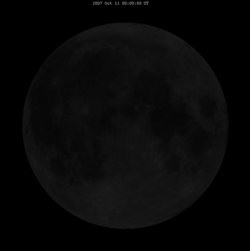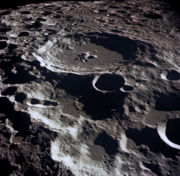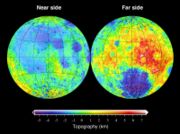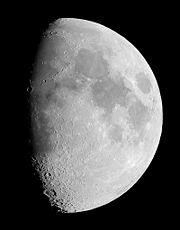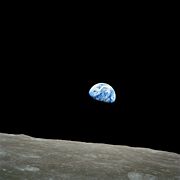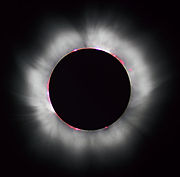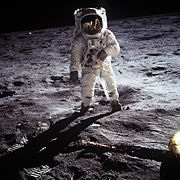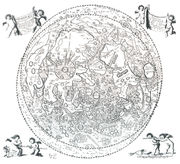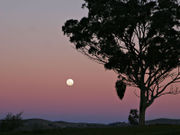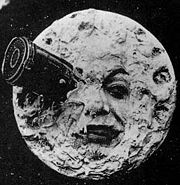Moon
2008/9 Schools Wikipedia Selection. Related subjects: Space (Astronomy)
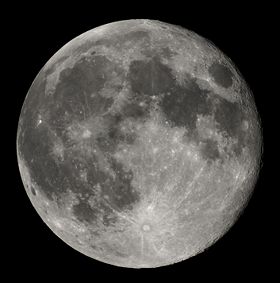
|
||||||||||
|
Orbital characteristics
|
||||||||||
|---|---|---|---|---|---|---|---|---|---|---|
| Perigee | 363,104 km (0.0024 AU) | |||||||||
| Apogee | 405,696 km (0.0027 AU) | |||||||||
| Semi-major axis | 384,399 km (0.00257 AU) | |||||||||
| Eccentricity | 0.0549 | |||||||||
| Orbital period | 27.321582 d (27 d 7 h 43.1 min) | |||||||||
| Synodic period | 29.530588 d (29 d 12 h 44.0 min) | |||||||||
| Average orbital speed | 1.022 k m/s | |||||||||
| Inclination | 5.145° to the ecliptic (between 18.29° and 28.58° to Earth's equator) |
|||||||||
| Longitude of ascending node | regressing by one revolution in 18.6 years | |||||||||
| Argument of perigee | progressing by one revolution in 8.85 years | |||||||||
| Satellite of | Earth | |||||||||
|
Physical characteristics
|
||||||||||
| Mean radius | 1,737.10 km (0.273 Earths) | |||||||||
| Equatorial radius | 1,738.14 km (0.273 Earths) | |||||||||
| Polar radius | 1,735.97 km (0.273 Earths) | |||||||||
| Flattening | 0.00125 | |||||||||
| Circumference | 10,921 km ( equatorial) | |||||||||
| Surface area | 3.793×107 km² (0.074 Earths) | |||||||||
| Volume | 2.1958×1010 k m³ (0.020 Earths) | |||||||||
| Mass | 7.3477×1022 kg (0.0123 Earths) | |||||||||
| Mean density | 3,346.4 kg/m³ | |||||||||
| Equatorial surface gravity | 1.622 m/s² (0.1654 g) | |||||||||
| Escape velocity | 2.38 k m/s | |||||||||
| Sidereal rotation period |
27.321582 d ( synchronous) | |||||||||
| Equatorial rotation velocity | 4.627 m/s | |||||||||
| Axial tilt | 1.5424° (to ecliptic) 6.687° (to orbit plane) |
|||||||||
| Albedo | 0.12 | |||||||||
| Surface temp. equator 85°N |
|
|||||||||
| Apparent magnitude | –2.5 to –12.9 –12.74 (mean full moon) |
|||||||||
| Angular diameter | 29.3 to 34.1 arcminutes | |||||||||
| Adjectives | "lunar" | |||||||||
The Moon (Latin: Luna) is Earth's only natural satellite and the fifth largest natural satellite in the Solar System.
The average centre-to-centre distance from the Earth to the Moon is 384,403 km, about thirty times the diameter of the Earth. The Moon's diameter is 3,474 km, a little more than a quarter that of the Earth. This means that the Moon's volume is about 2 percent that of Earth and the pull of gravity at its surface about 17 percent that of the Earth. The Moon makes a complete orbit around the Earth every 27.3 days, and the periodic variations in the geometry of the Earth–Moon–Sun system are responsible for the lunar phases that repeat every 29.5 days.
The Moon is the only celestial body to which humans have travelled and upon which humans have landed. The first artificial object to escape Earth's gravity and pass near the Moon was the Soviet Union's Luna 1, the first artificial object to impact the lunar surface was Luna 2, and the first photographs of the normally occluded far side of the Moon were made by Luna 3, all in 1959. The first spacecraft to perform a successful lunar soft landing was Luna 9, and the first unmanned vehicle to orbit the Moon was Luna 10, both in 1966. The United States (U.S.) Apollo program achieved the only manned missions to date, resulting in six landings between 1969 and 1972. Human exploration of the Moon ceased with the conclusion of the Apollo program, although several countries have announced plans to send people or robotic spacecraft to the Moon.
Name and etymology
Unlike the moons of other planets, the moon of the Earth has no proper English name other than "the Moon" (capitalized).
The word moon is a Germanic word, related to Latin mensis; it is ultimately a derivative of the Proto-Indo-European root me-, also represented in measure (time), with reminders of its importance in measuring time in words derived from it like Monday, month and menstrual. In English, the word moon exclusively meant "the Moon" until 1665, when it was extended to refer to the recently-discovered natural satellites of other planets. The Moon is occasionally referred to by its Latin name, Luna, in order to distinguish it from other natural satellites, with a related adjective lunar, and an adjectival prefix seleno- or suffix -selene (from the Greek deity Selene).
Lunar surface
Two sides of the Moon
The Moon is in synchronous rotation, meaning that it keeps nearly the same face turned towards the Earth at all times. Early in the Moon's history, its rotation slowed and became locked in this configuration as a result of frictional effects associated with tidal deformations caused by the Earth.
Long ago when the Moon spun much faster, its tidal bulge preceded the Earth-Moon line because it couldn't "snap back" its bulges quickly enough to keep its bulges in line with Earth. The rotation swept the bulge beyond the Earth-Moon line. This out-of-line bulge caused a torque, slowing the Moon spin, like a wrench tightening a nut. When the Moon's spin slowed enough to match its orbital rate, then the bulge always faced Earth, the bulge was in line with Earth, and the torque disappeared. That is why the Moon rotates at the same rate as it orbits and we always see the same side of the Moon.
Small variations ( libration) in the angle from which the Moon is seen allow about 59% of its surface to be seen from the earth (but only half at any instant).
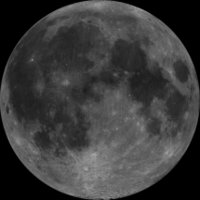 |
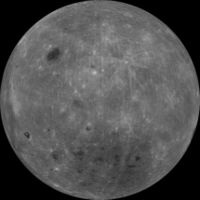 |
|
| Near side of the Moon | Far side of the Moon |
The side of the Moon that faces Earth is called the near side, and the opposite side the far side. The far side should not be confused with the dark side, which is the hemisphere that is not being illuminated by the Sun at a given moment (this may be the side facing the Earth, as it is once a month during the New Moon phase). The far side of the Moon was first photographed by the Soviet probe Luna 3 in 1959. One distinguishing feature of the far side is its almost complete lack of maria.
Maria
The dark and relatively featureless lunar plains which can clearly be seen with the naked eye are called maria (singular mare), Latin for seas, since they were believed by ancient astronomers to be filled with water. These are now known to be vast solidified pools of ancient basaltic lava. The majority of these lavas erupted or flowed into the depressions associated with impact basins that formed by the collisions of meteors and comets with the lunar surface. ( Oceanus Procellarum is a major exception in that it does not correspond to a known impact basin). Maria are found almost exclusively on the near side of the Moon, with the far side having only a few scattered patches covering only about 2% of its surface, compared with about 31% on the near side. The most likely explanation for this difference is related to a higher concentration of heat-producing elements on the near-side hemisphere, as has been demonstrated by geochemical maps obtained from the Lunar Prospector gamma-ray spectrometer. Several provinces containing shield volcanoes and volcanic domes are found within the near side maria.
Terrae
The lighter-colored regions of the Moon are called terrae, or more commonly just highlands, since they are higher than most maria. Several prominent mountain ranges on the near side are found along the periphery of the giant impact basins, many of which have been filled by mare basalt. These are believed to be the surviving remnants of the impact basin's outer rims. In contrast to the Earth, no major lunar mountains are believed to have formed as a result of tectonic events.
From images taken by the Clementine mission in 1994, it appears that four mountainous regions on the rim of the 73 km-wide Peary crater at the Moon's north pole remain illuminated for the entire lunar day. These peaks of eternal light are possible because of the Moon's extremely small axial tilt to the ecliptic plane. No similar regions of eternal light were found at the south pole, although the rim of Shackleton crater is illuminated for about 80% of the lunar day. Another consequence of the Moon's small axial tilt is regions that remain in permanent shadow at the bottoms of many polar craters.
Impact craters
The Moon's surface shows obvious evidence of having been affected by impact cratering. Impact craters form when asteroids and comets collide with the lunar surface, and globally about half a million craters with diameters greater than 1 km can be found. Since impact craters accumulate at a nearly constant rate, the number of craters per unit area superposed on a geologic unit can be used to estimate the age of the surface (see crater counting). The lack of an atmosphere, weather and recent geological processes ensures that many of these craters have remained relatively well preserved in comparison to those found on Earth.
The largest crater on the Moon, which also has the distinction of being the largest known crater in the Solar System, is the South Pole-Aitken basin. This impact basin is located on the far side, between the South Pole and equator, and is some 2240 km in diameter and 13 km in depth. Prominent impact basins on the near side include Imbrium, Serenitatis, Crisium, and Nectaris.
Regolith
Blanketed atop the Moon's crust is a highly comminuted (broken into ever smaller particles) and "impact gardened" surface layer called regolith. Since the regolith forms by impact processes, the regolith of older surfaces is generally thicker than for younger surfaces. In particular, it has been estimated that the regolith varies in thickness from about 3–5 m in the maria, and by about 10–20 m in the highlands. Beneath the finely comminuted regolith layer is what is generally referred to as the megaregolith. This layer is much thicker (on the order of tens of kilometres) and comprises highly fractured bedrock.
Presence of water
The continuous bombardment of the Moon by comets and meteoroids has most likely added small amounts of water to the lunar surface. If so, sunlight would split much of this water into its constituent elements of hydrogen and oxygen, both of which would ordinarily escape into space over time, because of the Moon's weak gravity. However, because of the slightness of the axial tilt of the Moon's spin axis to the ecliptic plane—only 1.5°—some deep craters near the poles never receive direct light from the Sun and are thus in permanent shadow (see Shackleton crater). Water molecules that ended up in these craters could be stable for long periods of time.
Clementine has mapped craters at the lunar south pole that are shadowed in this way, and computer simulations suggest that up to 14,000 km² might be in permanent shadow. Results from the Clementine mission bistatic radar experiment are consistent with small, frozen pockets of water close to the surface, and data from the Lunar Prospector neutron spectrometer indicate that anomalously high concentrations of hydrogen are present in the upper metre of the regolith near the polar regions. Estimates for the total quantity of water ice are close to one cubic kilometre.
Water ice can be mined and then split into its constituent hydrogen and oxygen atoms by means of nuclear generators or electric power stations equipped with solar panels. The presence of usable quantities of water on the Moon is an important factor in rendering lunar habitation cost-effective, since transporting water from Earth would be prohibitively expensive. However, recent observations made with the Arecibo planetary radar suggest that some of the near-polar Clementine radar data that were previously interpreted as being indicative of water ice might instead be a result of rocks ejected from young impact craters. The question of how much water there is on the Moon has not been resolved.
Physical characteristics
Internal structure
The Moon is a differentiated body, being composed of a geochemically distinct crust, mantle, and core. This structure is believed to have resulted from the fractional crystallization of a magma ocean shortly after its formation about 4.5 billion years ago. The energy required to melt the outer portion of the Moon is commonly attributed to a giant impact event that is postulated to have formed the Earth-Moon system, and the subsequent reaccretion of material in Earth orbit. Crystallization of this magma ocean would have given rise to a mafic mantle and a plagioclase-rich crust (see Origin and geologic evolution below).
Geochemical mapping from orbit implies that the crust of the Moon is largely anorthositic in composition, consistent with the magma ocean hypothesis. In terms of elements, the crust is composed primarily of oxygen, silicon, magnesium, iron, calcium, and aluminium. Based on geophysical techniques, its thickness is estimated to be on average about 50 km.
Partial melting within the mantle of the Moon gave rise to the eruption of mare basalts on the lunar surface. Analyses of these basalts indicate that the mantle is composed predominantly of the minerals olivine, orthopyroxene and clinopyroxene, and that the lunar mantle is more iron rich than that of the Earth. Some lunar basalts contain high abundances of titanium (present in the mineral ilmenite), suggesting that the mantle is highly heterogeneous in composition. Moonquakes have been found to occur deep within the mantle of the Moon about 1,000 km below the surface. These occur with monthly periodicities and are related to tidal stresses caused by the eccentric orbit of the Moon about the Earth.
The Moon has a mean density of 3,346.4 kg/m³, making it the second densest moon in the Solar System after Io. Nevertheless, several lines of evidence imply that the core of the Moon is small, with a radius of about 350 km or less. This corresponds to only about 20% the size of the Moon, in contrast to about 50% as is the case for most other terrestrial bodies. The composition of the lunar core is not well constrained, but most believe that it is composed of metallic iron alloyed with a small amount of sulfur and nickel. Analyses of the Moon's time-variable rotation indicate that the core is at least partly molten.
Topography
The topography of the Moon has been measured by the methods of laser altimetry and stereo image analysis, most recently from data obtained during the Clementine mission. The most visible topographic feature is the giant far side South Pole-Aitken basin, which possesses the lowest elevations of the Moon. The highest elevations are found just to the north-east of this basin, and it has been suggested that this area might represent thick ejecta deposits that were emplaced during an oblique South Pole-Aitken basin impact event. Other large impact basins, such as Imbrium, Serenitatis, Crisium, Smythii, and Orientale, also possess regionally low elevations and elevated rims. Another distinguishing feature of the Moon's shape is that the elevations are on average about 1.9 km higher on the far side than the near side.
Gravity field
The gravitational field of the Moon has been determined through tracking of radio signals emitted by orbiting spacecraft. The principle used depends on the Doppler effect, whereby the spacecraft acceleration in the line-of-sight direction can be determined by means of small shifts in frequency of the radio signal, and the distance from the spacecraft to a station on Earth. However, because of the Moon's synchronous rotation it is not possible to track spacecraft much over the limbs of the Moon, and the farside gravity field is thus only poorly characterised.
The major characteristic of the Moon's gravitational field is the presence of mascons, which are large positive gravitational anomalies associated with some of the giant impact basins. These anomalies greatly influence the orbit of spacecraft about the Moon, and an accurate gravitational model is necessary in the planning of both manned and unmanned missions. The mascons are in part due to the presence of dense mare basaltic lava flows that fill some of the impact basins. However, lava flows by themselves can not explain the entirety of the gravitational signature, and uplift of the crust-mantle interface is required as well. Based on Lunar Prospector gravitational models, it has been suggested that some mascons exist that do not show evidence for mare basaltic volcanism. The huge expanse of mare basaltic volcanism associated with Oceanus Procellarum does not possess a positive gravitational anomaly.
Magnetic field
The Moon has an external magnetic field of the order of one to a hundred nanotesla—more than 100 times smaller than the Earth's, which is 30-60 microtesla. Other major differences are that the Moon does not currently have a dipolar magnetic field (as would be generated by a geodynamo in its core), and the magnetizations that are present are almost entirely crustal in origin. One hypothesis holds that the crustal magnetizations were acquired early in lunar history when a geodynamo was still operating. The small size of the lunar core, however, is a potential obstacle to this theory. Alternatively, it is possible that on an airless body such as the Moon, transient magnetic fields could be generated during large impact events. In support of this, it has been noted that the largest crustal magnetizations appear to be located near the antipodes of the giant impact basins. It has been proposed that such a phenomenon could result from the free expansion of an impact generated plasma cloud around the Moon in the presence of an ambient magnetic field.
Atmosphere
The Moon has an atmosphere so thin as to be almost negligible, with a total atmospheric mass of less than 104 kg. One source of its atmosphere is outgassing—the release of gases such as radon that originate by radioactive decay processes within the crust and mantle. Another important source is generated through the process of sputtering, which involves the bombardment of micrometeorites, solar wind ions, electrons, and sunlight. Gases that are released by sputtering can either reimplant into the regolith as a result of the Moon's gravity, or can be lost to space either by solar radiation pressure or by being swept away by the solar wind magnetic field if they are ionised. The elements sodium (Na) and potassium (K) have been detected using earth-based spectroscopic methods, whereas the element radon–222 (222Rn) and polonium-210 (210Po) have been inferred from data obtained from the Lunar Prospector alpha particle spectrometer. Argon–40 (40Ar), helium-4 (4He), oxygen (O2) and/or methane (CH4), nitrogen (N2) and/or carbon monoxide (CO), and carbon dioxide (CO2) were detected by in-situ detectors placed by the Apollo astronauts.
Surface Temperature
During the lunar day, the surface temperature averages 107°C, and during the lunar night, it averages -153°C.
Origin and geologic evolution
Formation
Several mechanisms have been suggested for the Moon's formation. The formation of the Moon is believed to have occurred 4.527 ± 0.010 billion years ago, about 30–50 million years after the origin of the Solar System.
- Fission theory
- Early speculation proposed that the Moon broke off from the Earth's crust because of centrifugal forces, leaving a basin – presumed to be the Pacific Ocean – behind as a scar. This idea, however, would require too great an initial spin of the Earth; and, even had this been possible, the process should have resulted in the Moon's orbit following Earth's equatorial plane. This is not the case.
- Capture theory
- Other speculation has centered on the Moon being formed elsewhere and subsequently being captured by Earth's gravity. However, the conditions believed necessary for such a mechanism to work, such as an extended atmosphere of the Earth in order to dissipate the energy of the passing Moon, are improbable.
- Co-formation theory
- The co-formation hypothesis proposes that the Earth and the Moon formed together at the same time and place from the primordial accretion disk. The Moon would have formed from material surrounding the proto-Earth, similar to the formation of the planets around the Sun. Some suggest that this hypothesis fails adequately to explain the depletion of metallic iron in the Moon.
A major deficiency in all these hypotheses is that they cannot readily account for the high angular momentum of the Earth–Moon system.
- Giant Impact theory
- The prevailing hypothesis today is that the Earth–Moon system formed as a result of a giant impact. A Mars-sized body (labelled "Theia") is believed to have hit the proto-Earth, blasting sufficient material into orbit around the proto-Earth to form the Moon through accretion. As accretion is the process by which all planetary bodies are believed to have formed, giant impacts are thought to have affected most if not all planets. Computer simulations modelling a giant impact are consistent with measurements of the angular momentum of the Earth–Moon system, as well as the small size of the lunar core. Unresolved questions regarding this theory concern the determination of the relative sizes of the proto-Earth and Theia and of how much material from these two bodies formed the Moon.
Lunar magma ocean
As a result of the large amount of energy liberated during both the giant impact event and the subsequent reaccretion of material in Earth orbit, it is commonly believed that a large portion of the Moon was once initially molten. The molten outer portion of the Moon at this time is referred to as a magma ocean, and estimates for its depth range from about 500 km to the entire radius of the Moon.
As the magma ocean cooled, it fractionally crystallised and differentiated, giving rise to a geochemically distinct crust and mantle. The mantle is inferred to have formed largely by the precipitation and sinking of the minerals olivine, clinopyroxene, and orthopyroxene. After about three-quarters of magma ocean crystallisation was complete, the mineral anorthite is inferred to have precipitated and floated to the surface because of its low density, forming the crust.
The final liquids to crystallise from the magma ocean would have been initially sandwiched between the crust and mantle, and would have contained a high abundance of incompatible and heat-producing elements. This geochemical component is referred to by the acronym KREEP, for potassium (K), rare earth elements (REE), and phosphorus (P), and appears to be concentrated within the Procellarum KREEP Terrane, which is a small geologic province that encompasses most of Oceanus Procellarum and Mare Imbrium on the near side of the Moon.
Geologic evolution
A large portion of the Moon's post–magma-ocean geologic evolution was dominated by impact cratering. The lunar geologic timescale is largely divided in time on the basis of prominent basin-forming impact events, such as Nectaris, Imbrium, and Orientale. These impact structures are characterised by multiple rings of uplifted material, and are typically hundreds to thousands of kilometres in diameter. Each multi-ring basin is associated with a broad apron of ejecta deposits that forms a regional stratigraphic horizon. While only a few multi-ring basins have been definitively dated, they are useful for assigning relative ages on the basis of stratigraphic grounds. The continuous effects of impact cratering are responsible for forming the regolith.
The other major geologic process that affected the Moon's surface was mare volcanism. The enhancement of heat-producing elements within the Procellarum KREEP Terrane is thought to have caused the underlying mantle to heat up, and eventually, to partially melt. A portion of these magmas rose to the surface and erupted, accounting for the high concentration of mare basalts on the near side of the Moon. Most of the Moon's mare basalts erupted during the Imbrian period in this geologic province 3.0–3.5 billion years ago. Nevertheless, some dated samples are as old as 4.2 billion years, and the youngest eruptions, based on the method of crater counting, are believed to have occurred only 1.2 billion years ago.
There has been controversy over whether features on the Moon's surface undergo changes over time. Some observers have claimed that craters either appeared or disappeared, or that other forms of transient phenomena had occurred. Today, many of these claims are thought to be illusory, resulting from observation under different lighting conditions, poor astronomical seeing, or the inadequacy of earlier drawings. Nevertheless, it is known that the phenomenon of outgassing does occasionally occur, and these events could be responsible for a minor percentage of the reported lunar transient phenomena. Recently, it has been suggested that a roughly 3 km diameter region of the lunar surface was modified by a gas release event about a million years ago.
Moon rocks
Moon rocks fall into two main categories, based on whether they underlie the lunar highlands (terrae) or the maria. The lunar highlands rocks are composed of three suites: the ferroan anorthosite suite, the magnesian suite, and the alkali suite (some consider the alkali suite to be a subset of the mg-suite). The ferroan anorthosite suite rocks are composed almost exclusively of the mineral anorthite (a calic plagioclase feldspar), and are believed to represent plagioclase flotation cumulates of the lunar magma ocean. The ferroan anorthosites have been dated using radiometric methods to have formed about 4.4 billion years ago.
The mg- and alkali-suite rocks are predominantly mafic plutonic rocks. Typical rocks are dunites, troctolites, gabbros, alkali anorthosites, and more rarely, granite. In contrast to the ferroan anorthosite suite, these rocks all have relatively high Mg/Fe ratios in their mafic minerals. In general, these rocks represent intrusions into the already-formed highlands crust (though a few rare samples appear to represent extrusive lavas), and they have been dated to have formed about 4.4–3.9 billion years ago. Many of these rocks have high abundances of, or are genetically related to, the geochemical component KREEP.
The lunar maria consist entirely of mare basalts. While similar to terrestrial basalts, they have much higher abundances of iron, are completely lacking in hydrous alteration products, and have a large range of titanium abundances.
Astronauts have reported that the dust from the surface felt like snow and smelled like spent gunpowder. The dust is mostly made of silicon dioxide glass (SiO2), most likely created from the meteors that have crashed into the Moon's surface. It also contains calcium and magnesium.
Orbit and relationship to Earth
The Moon makes a complete orbit around the Earth with respect to the fixed stars (its sidereal period) about once every 27.3 days. However, since the Earth is moving in its orbit about the Sun at the same time, it takes slightly longer for the Moon to show its same phase to Earth, which is about 29.5 days (its synodic period). Unlike most satellites of other planets, the Moon orbits near the ecliptic and not the Earth's equatorial plane. It is the largest moon in the solar system relative to the size of its planet. ( Charon is larger relative to the dwarf planet Pluto.) The natural satellites orbiting other planets are called "moons", after Earth's Moon.
Most of the tidal effects seen on the Earth are caused by the Moon's gravitational pull, with the Sun making only a small contribution. Tidal effects result in an increase of the mean Earth-Moon distance of about 3.8 m per century, or 3.8 cm per year. As a result of the conservation of angular momentum, the increasing semimajor axis of the Moon is accompanied by a gradual slowing of the Earth's rotation by about 0.002 seconds per day per century.
The Earth–Moon system is sometimes considered to be a double planet rather than a planet–moon system. This is due to the exceptionally large size of the Moon relative to its host planet; the Moon is a quarter the diameter of Earth and 1/81 its mass. However, this definition is criticised by some, since the common centre of mass of the system (the barycentre) is located about 1700 km beneath the surface of the Earth, or about a quarter of the Earth's radius. The surface of the Moon is less than 1/10th that of the Earth, and only about a quarter the size of the Earth's land area (or about as large as Russia, Canada, and the U.S. combined).
In 1997, the asteroid 3753 Cruithne was found to have an unusual Earth-associated horseshoe orbit. However, astronomers do not consider it to be a second moon of Earth, and its orbit is not stable in the long term. Three other near-Earth asteroids, (54509) 2000 PH5, (85770) 1998 UP1 and 2002 AA29, which exist in orbits similar to Cruithne's, have since been discovered.

Ocean tides
Earth’s ocean tides are initiated by the tidal force (a gradient in intensity) of Moon’s gravity and are magnified by a host of effects in Earth’s oceans. The gravitational tidal force arises because the side of Earth facing the Moon (nearest it) is attracted more strongly by the Moon’s gravity than is the center of the Earth and—even less so—the Earth’s far side. The gravitational tide stretches the Earth’s oceans into an ellipse with the Earth in the centre. The effect takes the form of two bulges—elevated sea level relative to the Earth; one nearest the Moon and one farthest from it. Since these two bulges rotate around the Earth once a day as it spins on its axis, ocean water is continuously rushing towards the ever-moving bulges. The effects of the two bulges and the massive ocean currents chasing them are magnified by an interplay of other effects; namely frictional coupling of water to Earth’s rotation through the ocean floors, inertia of water’s movement, ocean basins that get shallower near land, and oscillations between different ocean basins. The magnifying effect is a bit like water sloshing high up the sloped end of a bathtub after a relatively small disturbance of one’s body in the deep part of the tub.
Gravitational coupling between the Moon and the ocean bulge nearest the Moon affects its orbit. The Earth rotates on its axis in the very same direction, and roughly 27 times faster, than the Moon orbits the Earth. Thus, frictional coupling between the sea floors and ocean waters, as well as water’s inertia, drags the peak of the near-Moon tidal bulge slightly forward of the imaginary line connecting the centers of the Earth and Moon. From the Moon’s perspective, the centre of mass of the near-Moon tidal bulge is perpetually slightly ahead of the point about which it is orbiting. Precisely the opposite effect occurs with the bulge farthest from the Moon; it lags behind the imaginary line. However it is 12,756 km farther away and has slightly less gravitational coupling to the Moon. Consequently, the Moon is constantly being gravitationally attracted forward in its orbit about the Earth. This gravitational coupling drains kinetic energy and angular momentum from the Earth’s rotation (see also, Day and Leap second). In turn, angular momentum is added to the Moon’s orbit, which lifts the Moon into a higher orbit with a longer period. The effect on the Moon’s orbital radius is a small one, just 0.10 ppb/year, but results in a measurable 3.82 cm annual increase in the Earth-Moon distance. Cumulatively, this effect becomes ever more significant over time; since when astronauts first landed on the Moon approximately 39 years ago, it is now 1.49 metres farther away.
Eclipses
Eclipses can occur only when the Sun, Earth, and Moon are all in a straight line. Solar eclipses occur near a new moon, when the Moon is between the Sun and Earth. In contrast, lunar eclipses occur near a full moon, when the Earth is between the Sun and Moon.
Because the Moon's orbit around the Earth is inclined by about 5° with respect to the orbit of the Earth around the Sun, eclipses do not occur at every full and new moon. For an eclipse to occur, the Moon must be near the intersection of the two orbital planes.
The periodicity and recurrence of eclipses of the Sun by the Moon, and of the Moon by the Earth, is described by the saros cycle, which has a period of approximately 6,585.3 days (18 years 11 days 8 hours).
The angular diameters of the Moon and the Sun as seen from Earth overlap in their variation, so that both total and annular solar eclipses are possible. In a total eclipse, the Moon completely covers the disc of the Sun and the solar corona becomes visible to the naked eye. Since the distance between the Moon and the Earth is very slightly increasing over time, the angular diameter of the Moon is decreasing. This means that hundreds of millions of years ago the Moon could always completely cover the Sun on solar eclipses so that no annular eclipses were possible. Likewise, about 600 million years from now (assuming that the angular diameter of the Sun will not change), the Moon will no longer cover the Sun completely and only annular eclipses will occur.
A phenomenon related to eclipse is occultation. The Moon is continuously blocking our view of the sky by a 1/2 degree-wide circular area. When a bright star or planet passes behind the Moon it is occulted or hidden from view. A solar eclipse is an occultation of the Sun. Because the Moon is close to Earth, occultations of individual stars are not visible everywhere, nor at the same time. Because of the precession of the lunar orbit, each year different stars are occulted.
The most recent lunar eclipse was on February 20, 2008. It was a total eclipse. The entire event was visible from South America and most of North America (on Feb. 20), as well as Western Europe, Africa, and western Asia (on Feb. 21). The most recent solar eclipse took place on September 11, 2007, visible from southern South America and parts of Antarctica. The next total solar eclipse, on August 1, 2008, will have a path of totality beginning in northern Canada and passing through Russia and China.
Observation
During its brightest phase, at "full moon", the Moon has an apparent magnitude of about −12.6. By comparison, the Sun has an apparent magnitude of −26.8. When the Moon is in a quarter phase, its brightness is not half of a full moon, but only about a tenth. This is because the lunar surface is not a perfect Lambertian reflector. When the Moon is full the opposition effect makes it appear brighter, but away from full there are shadows projected onto the surface which diminish the amount of reflected light.
The Moon appears larger when close to the horizon. This is a purely psychological effect (see Moon illusion). It is actually about 1.5% smaller when the Moon is near the horizon than when it is high in the sky (because it is farther away by up to one Earth radius).
The moon appears as a relatively bright object in the sky, in spite of its low albedo. The Moon is about the poorest reflector in the solar system and reflects only about 7% of the light incident upon it (about the same proportion as is reflected by a lump of coal). Colour constancy in the visual system recalibrates the relations between the colours of an object and its surroundings, and since the surrounding sky is comparatively dark the sunlit Moon is perceived as a bright object.
The highest altitude of the Moon on a day varies and has nearly the same limits as the Sun. It also depends on the Earth season and lunar phase, with the full moon being highest in winter. Moreover, the 18.6 year nodes cycle also has an influence, as when the ascending node of the lunar orbit is in the vernal equinox, the lunar declination can go as far as 28° each month (which happened most recently in 2006). This results that the Moon can go overhead on latitudes till 28 degrees (e.g. Florida, Canary Islands or in the southern hemisphere Brisbane). Slightly more than 9 years later (next time in 2015) the declination reaches only 18° N or S each month. The orientation of the Moon's crescent also depends on the latitude of the observation site. Close to the equator, an observer can see a boat Moon.
Like the Sun, the Moon can give rise to atmospheric effects, including a 22° halo ring, and the smaller coronal rings seen more often through thin clouds. For more information on how the Moon appears in Earth's sky, see lunar phase.
Exploration
The first leap in lunar observation was prompted by the invention of the telescope. Galileo Galilei made good use of this new instrument and observed mountains and craters on the Moon's surface.
The Cold War-inspired space race between the Soviet Union and the U.S. led to an acceleration of interest in the Moon. Unmanned probes, both flyby and impact/lander missions, were sent almost as soon as launcher capabilities would allow. The Soviet Union's Luna program was the first to reach the Moon with unmanned spacecraft. The first man-made object to escape Earth's gravity and pass near the Moon was Luna 1, the first man-made object to impact the lunar surface was Luna 2, and the first photographs of the normally occluded far side of the Moon were made by Luna 3, all in 1959. The first spacecraft to perform a successful lunar soft landing was Luna 9 and the first unmanned vehicle to orbit the Moon was Luna 10, both in 1966. Moon samples have been brought back to Earth by three Luna missions ( Luna 16, 20, and 24) and the Apollo missions 11 to 17 (except Apollo 13, which aborted its planned lunar landing).
The landing of the first humans on the Moon in 1969 is seen as the culmination of the space race. Neil Armstrong became the first person to walk on the Moon as the commander of the American mission Apollo 11 by first setting foot on the Moon at 02:56 UTC on 21 July 1969. The American Moon landing and return was enabled by considerable technological advances, in domains such as ablation chemistry and atmospheric re-entry technology, in the early 1960s.
Scientific instrument packages were installed on the lunar surface during all of the Apollo missions. Long-lived ALSEP stations (Apollo lunar surface experiment package) were installed at the Apollo 12, 14, 15, 16, and 17 landing sites, whereas a temporary station referred to as EASEP (Early Apollo Scientific Experiments Package) was installed during the Apollo 11 mission. The ALSEP stations contained, among others, heat flow probes, seismometers, magnetometers, and corner-cube retroreflectors. Transmission of data to Earth was terminated on 30 September 1977 because of budgetary considerations. Since the lunar laser ranging (LLR) corner-cube arrays are passive instruments, they are still being used. Ranging to the LLR stations is routinely performed from earth-based stations with an accuracy of a few centimetres, and data from this experiment are being used to place constraints on the size of the lunar core.
35 years, 180 days have now passed since Eugene Cernan, as part of the mission Apollo 17, left the surface of the Moon on 14 December 1972 and no one has set foot on it since.
From the mid-1960s to the mid-1970s, there were 65 instances of artificial objects reaching the Moon (both manned and robotic, with ten in 1971 alone), with the last being Luna 24 in 1976. Only 18 of these were controlled moon landings, with nine completing a round trip from Earth and returning samples of moon rocks. The Soviet Union then turned its primary attention to Venus and space stations, and the U.S. to Mars and beyond. In 1990, Japan orbited the Moon with the Hiten spacecraft, becoming the third country to place a spacecraft into lunar orbit. The spacecraft released a smaller probe, Hagormo, in lunar orbit, but the transmitter failed, thereby preventing further scientific use of the mission.
In 1994, the U.S. finally returned to the Moon, robotically at least, sending the Joint Defense Department/NASA spacecraft Clementine. This mission obtained the first near-global topographic map of the Moon, and the first global multispectral images of the lunar surface. This was followed by the Lunar Prospector mission in 1998. The neutron spectrometer on Lunar Prospector indicated the presence of excess hydrogen at the lunar poles, which is likely to have been caused by the presence of water ice in the upper few metres of the regolith within permanently shadowed craters. The European spacecraft Smart 1 was launched September 27, 2003 and was in lunar orbit from November 15, 2004 to September 3, 2006.
On January 14, 2004, U.S. President George W. Bush called for a plan to return manned missions to the Moon by 2020 (see Vision for Space Exploration). NASA is now planning for the construction of a permanent outpost at one of the lunar poles. The People's Republic of China has expressed ambitious plans for exploring the Moon and has started the Chang'e program for lunar exploration, successfully launching its first spacecraft, Chang'e-1, on October 24, 2007. India intends to launch several unmanned missions, beginning with Chandrayaan I in February 2008, followed by Chandrayaan II in 2010 or 2011; the latter is slated to include a robotic lunar rover. India also has expressed its hope for a manned mission to the Moon by 2030. The U.S. will launch the Lunar Reconnaissance Orbiter in 2008. Russia also announced to resume its previously frozen project Luna-Glob, consisting of an unmanned lander and orbiter, which is slated to land in 2012.
The Google Lunar X Prize, announced 13 September 2007, hopes to boost and encourage privately funded lunar exploration. The X Prize Foundation is offering anyone 20 million dollars US who can land a robotic rover on the Moon and meet other specified criteria.
On September 14, 2007 the Japan Aerospace Exploration Agency launched SELENE a lunar orbiter which is fitted with a High Definition camera and two small satellites. The mission is expected to last one year.
Human understanding
The Moon has been the subject of many works of art and literature and the inspiration for countless others. It is a motif in the visual arts, the performing arts, poetry, prose and music. A 5,000-year-old rock carving at Knowth, Ireland may represent the Moon, which would be the earliest depiction discovered. In many prehistoric and ancient cultures, the Moon was thought to be a deity or other supernatural phenomenon, and astrological views of the Moon continue to be propagated today.
Among the first in the Western world to offer a scientific explanation for the Moon was the Greek philosopher Anaxagoras (d. 428 BC), who reasoned that the Sun and Moon were both giant spherical rocks, and that the latter reflected the light of the former. His atheistic view of the heavens was one cause for his imprisonment and eventual exile.
In Aristotle's (384–322 BC) description of the universe, the Moon marked the boundary between the spheres of the mutable elements (earth, water, air and fire), and the imperishable stars of aether. This separation was held to be part of physics for many centuries after.
During the Warring States of China, astronomer Shi Shen (fl. 4th century BC) gave instructions for predicting solar eclipse and lunar eclipse based on the relative positions of the moon and sun. Although the Chinese of the Han Dynasty (202 BC–202 AD) believed the moon to be energy equated to qi, their 'radiating influence' theory recognized that the light of the moon was merely a reflection of the sun (mentioned by Anaxagoras above). This was supported by mainstream thinkers such as Jing Fang (78–37 BC) and Zhang Heng (78–139 AD), but it was also opposed by the influential philosopher Wang Chong (27–97 AD). Jing Fang noted the sphericity of the moon, while Zhang Heng accurately described lunar eclipse and solar eclipse. These assertions were supported by Shen Kuo (1031–1095) of the Song Dynasty (960–1279) who created an allegory equating the waxing and waning of the moon to a round ball of reflective silver that, when doused with white powder and viewed from the side, would appear to be a crescent. He also noted that the reason for the sun and moon not eclipsing every time their paths met was because of a small obliquity in their orbital paths.
By the Middle Ages, before the invention of the telescope, more and more people began to recognise the Moon as a sphere, though they believed that it was "perfectly smooth". In 1609, Galileo Galilei drew one of the first telescopic drawings of the Moon in his book Sidereus Nuncius and noted that it was not smooth but had mountains and craters. Later in the 17th century, Giovanni Battista Riccioli and Francesco Maria Grimaldi drew a map of the Moon and gave many craters the names they still have today.
On maps, the dark parts of the Moon's surface were called maria (singular mare) or seas, and the light parts were called terrae or continents. The possibility that the Moon contains vegetation and is inhabited by selenites was seriously considered by major astronomers even into the first decades of the 19th century. The contrast between the brighter highlands and darker maria create the patterns seen by different cultures as the Man in the Moon, the rabbit and the buffalo, among others.
In 1835, the Great Moon Hoax fooled some people into thinking that there were exotic animals living on the Moon. Almost at the same time however (during 1834–1836), Wilhelm Beer and Johann Heinrich Mädler were publishing their four-volume Mappa Selenographica and the book Der Mond in 1837, which firmly established the conclusion that the Moon has no bodies of water nor any appreciable atmosphere.
The far side of the Moon remained completely unknown until the Luna 3 probe was launched in 1959, and was extensively mapped by the Lunar Orbiter program in the 1960s.
Legal status
Although several pennants of the Soviet Union were scattered by Luna 2 in 1959 and by later landing missions, and U.S. flags have been symbolically planted on the Moon, no nation currently claims ownership of any part of the Moon's surface. Russia and the U.S. are party to the Outer Space Treaty, which places the Moon under the same jurisdiction as international waters ( res communis). This treaty also restricts the use of the Moon to peaceful purposes, explicitly banning military installations and weapons of mass destruction (including nuclear weapons).
A second treaty, the Moon Treaty, was proposed to restrict the exploitation of the Moon's resources by any single nation, but it has not been signed by any of the space-faring nations. Several individuals have made claims to the Moon in whole or in part, although none of these is generally considered credible.
